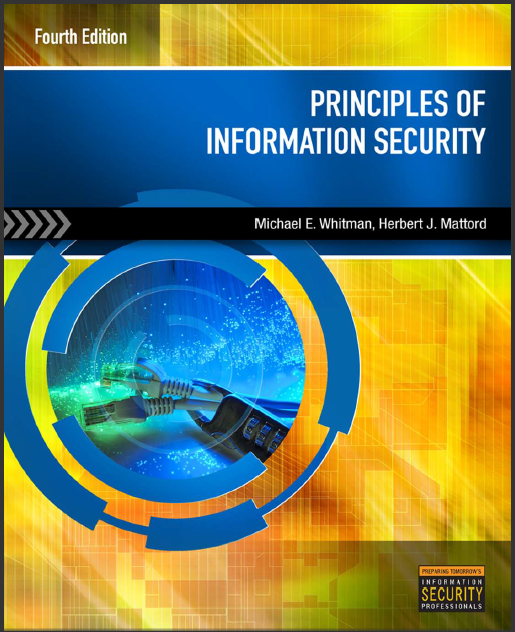Instruction Manual for Principles of Information Security 4th Edition by Michael Whitman, Herbert Mattord ISBN 1285448367 9781285448367
$70.00 Original price was: $70.00.$35.00Current price is: $35.00.
Instant download (Instruction Manual) Principles of Information Security 4th Edition after payment
Instruction Manual for Principles of Information Security 4th Edition by Michael Whitman, Herbert Mattord – Ebook PDF Instant Download/Delivery: 1285448367, 9781285448367
Full download Principles of Information Security 4th edition after payment

Product details:
ISBN 10: 1285448367
ISBN 13: 9781285448367
Author: Michael Whitman, Herbert Mattord
Specifically oriented to the needs of information systems students, PRINCIPLES OF INFORMATION SECURITY, 5e delivers the latest technology and developments from the field. Taking a managerial approach, this market-leading introductory book teaches all the aspects of information security-not just the technical control perspective. It provides a broad review of the entire field of information security, background on many related elements, and enough detail to facilitate understanding of the topic. It covers the terminology of the field, the history of the discipline, and an overview of how to manage an information security program. Current and relevant, the fifth edition includes the latest practices, fresh examples, updated material on technical security controls, emerging legislative issues, new coverage of digital forensics, and hands-on application of ethical issues in IS security. It is the ultimate resource for future business decision-makers.
Principles of Information Security 4th Table of contents:
Here is your table of contents in a clearer format, based on the structure you provided:
Chapter 1: Introduction to Information Security
1.1 The History of Information Security
1.1.1 The 1960s
1.1.2 The 1970s and 80s
1.1.3 The 1990s
1.1.4 2000 to Present
1.2 What Is Security?
1.3 Key Information Security Concepts
1.4 Critical Characteristics of Information
1.5 CNSS Security Model
1.6 Components of an Information System
1.6.1 Software
1.6.2 Hardware
1.6.3 Data
1.6.4 People
1.6.5 Procedures
1.6.6 Networks
1.7 Balancing Information Security and Access
1.8 Approaches to Information Security Implementation
1.9 Security in the Systems Life Cycle
1.9.1 The Systems Development Life Cycle
1.9.2 The Security Systems Development Life Cycle
1.9.3 Software Assurance—Security in the SDLC
1.10 Software Design Principles
1.11 The NIST Approach to Securing the SDLC
1.12 Security Professionals and the Organization
1.12.1 Senior Management
1.12.2 Information Security Project Team
1.12.3 Data Responsibilities
1.12.4 Communities of Interest
1.12.5 Information Security Management and Professionals
1.12.6 Information Technology Management and Professionals
1.12.7 Organizational Management and Professionals
1.13 Information Security: Is It an Art or a Science?
1.13.1 Security as Art
1.13.2 Security as Science
1.13.3 Security as a Social Science
1.14 Selected Readings
1.15 Chapter Summary
1.16 Review Questions
1.17 Exercises
1.18 Case Exercises
Chapter 2: The Need for Security
2.1 Threats and Attacks
2.1.1 2.5 Billion Potential Hackers
2.1.2 Other Studies of Threats
2.1.3 Common Attack Pattern Enumeration and Classification (CAPEC)
2.1.4 The 12 Categories of Threats
2.1.5 Compromises to Intellectual Property
2.1.6 Software Piracy
2.1.7 Copyright Protection and User Registration
2.1.8 Deviations in Quality of Service
2.1.9 Internet Service Issues
2.1.10 Communications and Other Service Provider Issues
2.1.11 Power Irregularities
2.1.12 Espionage or Trespass
2.1.13 Hackers
2.1.14 Hacker Variants
2.1.15 Password Attacks
2.1.16 Forces of Nature
2.1.17 Fire, Floods, Earthquakes, and Other Natural Disasters
2.2 Human Error or Failure
2.2.1 Social Engineering
2.2.2 Information Extortion
2.2.3 Sabotage or Vandalism
2.2.4 Online Activism
2.3 Software Attacks
2.3.1 Malware
2.3.2 Back Doors
2.3.3 Denial-of-Service (DoS) and Distributed Denial-of-Service (DDoS) Attacks
2.3.4 E-mail Attacks
2.3.5 Communications Interception Attacks
2.4 Technical Hardware Failures or Errors
2.4.1 The Intel Pentium CPU Failure
2.4.2 Mean Time Between Failure
2.5 Technical Software Failures or Errors
2.5.1 The OWASP Top 10
2.5.2 The Deadly Sins in Software Security
2.6 Technological Obsolescence
2.7 Theft
2.8 Selected Readings
2.9 Chapter Summary
2.10 Review Questions
2.11 Exercises
2.12 Case Exercises
Chapter 3: Legal, Ethical, and Professional Issues in Information Security
3.1 Law and Ethics in Information Security
3.2 Organizational Liability and the Need for Counsel
3.3 Policy Versus Law
3.4 Types of Law
3.5 Relevant U.S. Laws
3.5.1 General Computer Crime Laws
3.5.2 Export and Espionage Laws
3.5.3 U.S. Copyright Law
3.5.4 Financial Reporting
3.5.5 Freedom of Information Act of 1966
3.5.6 Payment Card Industry Data Security Standards (PCI DSS)
3.5.7 State and Local Regulations
3.6 International Laws and Legal Bodies
3.6.1 U.K. Computer Security Laws
3.6.2 Australian Computer Security Laws
3.6.3 Council of Europe Convention on Cybercrime
3.6.4 World Trade Organization and the Agreement on Trade-Related Aspects of Intellectual Property Rights
3.6.5 Digital Millennium Copyright Act
3.7 Ethics and Information Security
3.8 Ethical Differences Across Cultures
3.9 Ethics and Education
3.10 Deterring Unethical and Illegal behavior
3.11 Codes of Ethics at Professional Organizations
3.12 Major Information Security Professional Organizations
3.13 Key U.S. Federal Agencies
3.13.1 Department of Homeland Security
3.13.2 U.S. Secret Service
3.13.3 Federal Bureau of Investigation (FBI)
3.13.4 National Security Agency (NSA)
3.14 Selected Readings
3.15 Chapter Summary
3.16 Review Questions
3.17 Exercises
3.18 Case Exercises
People also search for Principles of Information Security 4th:
principles of information security 4th edition chapter 1 ppt
principles of information security fourth edition
principles of information security 7th edition
principles of computer security fourth edition gregory b white
basic principles of information security
Tags:
Michael Whitman,Herbert Mattord,Principles of Information


